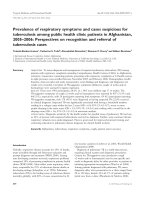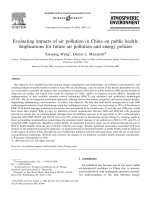- Trang chủ >>
- Khoa Học Tự Nhiên >>
- Vật lý
public health ethics and equity feb 2005
Bạn đang xem bản rút gọn của tài liệu. Xem và tải ngay bản đầy đủ của tài liệu tại đây (1.64 MB, 329 trang )
PUBLIC HEALTH, ETHICS, AND EQUITY
This page intentionally left blank
Public Health, Ethics,
and Equity
Edited by
SUDHIR ANAND
FABIENNE PETER
AMARTYA SEN
1
1
Great Clarendon Street, Oxford OX2 6DP
Oxford University Press is a department of the University of Oxford.
It furthers the University’s objective of excellence in research, scholarship,
and education by publishing worldwide in Oxford New York
Auckland Cape Town Dar es Salaam Hong Kong Karachi
Kuala Lumpur Madrid Melbourne Mexico City Nairobi
New Delhi Shanghai Taipei Toronto
With offices in
Argentina Austria Brazil Chile Czech Republic France Greece
Guatemala Hungary Italy Japan Poland Portugal Singapore
South Korea Switzerland Thailand Turkey Ukraine Vietnam
Oxford is a registered trade mark of Oxford University Press
in the UK and in certain other countries
Published in the United States
by Oxford University Press Inc., New York
© Oxford University Press, 2004
The moral rights of the authors have been asserted
Database right Oxford University Press (maker)
First published 2004
First published in paperback 2006
All rights reserved. No part of this publication may be reproduced, stored in
a retrieval system, or transmitted, in any form or by any means, without the
prior permission in writing of Oxford University Press,
or as expressly permitted by law, or under terms agreed with the appropriate
reprographics rights organization. Enquiries concerning reproduction
outside the scope of the above should be sent to the Rights Department,
Oxford University Press, at the address above
You must not circulate this book in any other binding or cover
and you must impose the same condition on any acquirer
British Library Cataloguing in Publication Data
Data available
Library of Congress Cataloging in Publication Data
Data available
Typeset by Newgen Imaging Systems (P) Ltd., Chennai, India
Printed in Great Britain
on acid-free paper by
CPI Bath Press
ISBN 0–19–927636–6 978–0–19–927636–3
ISBN 0–19–927637–4 (Pbk.) 978–0–19–927637–0 (Pbk.)
13579108642
Preface
This book originated in a set of workshops and seminars that we organised at
Harvard University in 1998 and 1999. Our objective in launching this series
of meetings was to initiate a wide investigation of the ethical issues underlying
inequalities in health. We were moved by the recognition that the extensive
empirical and policy literature on health inequalities had not been matched by
an adequate appreciation of the normative underpinnings of health equity. We
assembled, therefore, authors and commentators interested in these issues,
from a variety of disciplines, and invited them to contribute to this important
subject area. We were most encouraged by the wide interest generated by the
workshops and the lively discussions at the meetings. We are also deeply grate-
ful to the authors for their willingness to revise and restructure their papers,
taking note of the discussions, comments and written exchanges. Moreover, the
continuing involvement of many of the participants in the enquiry we initiated
has been extremely gratifying. The respective contributions made in different
chapters in this volume are briefly discussed in a separate Introduction.
The workshops and seminars were organised as part of the Global Health
Equity Initiative, and funded by a grant from the Rockefeller Foundation to
Harvard University. The later stages of the work in preparing, editing and pro-
ducing the volume for publication were supported by a grant from the
Rockefeller Foundation to St Catherine’s College, Oxford. We are very grateful
to the Foundation for its generous backing of this project.
SA, FP, AS
August 2004
Acknowledgements
Thanks are due to the following journals and publishers for giving us permission
to reprint:
“The Concern for Equity in Health” by Sudhir Anand, which originally
appeared in the Journal of Epidemiology and Community Health 56(7) 2002:
485–7; copyright BMJ publishing group
“Why Health Equity?” by Amartya Sen, which originally appeared in Health
Economics 11(8) 2002: 659–66; copyright John Wiley & Sons
“Health Equity and Social Justice” by Fabienne Peter, which originally
appeared in the Journal of Applied Philosophy 18(2) 2001: 159–70; copyright
Blackwell Publishers
“Disability-Adjusted Life Years: A Critical Review” by Sudhir Anand and
Kara Hanson, which originally appeared in the Journal of Health Economics
16(6) 1997: 685–702; copyright Elsevier
“Ethical Issues in the Use of Cost Effectiveness Analysis for the Prioritization
of Health Care Resources” by Dan Brock, which originally appeared in
Handbook of Bioethics: Taking Stock of the Field from a Philosophical
Perspective, edited by George Khushf. Dordrecht: Kluwer, 2004; copyright
Kluwer Academic Publishers.
Contents
List of Figures ix
List of Tables x
List of Abbreviations xi
List of Contributors xii
Introduction 1
Sudhir Anand and Fabienne Peter
Part I. Health Equity 13
1. The Concern for Equity in Health 15
Sudhir Anand
2. Why Health Equity? 21
Amartya Sen
Part II. Health, Society, and Justice 35
3. Social Causes of Social Inequalities in Health 37
Michael Marmot
4. Health and Inequality, or, Why Justice is Good for Our Health 63
Norman Daniels, Bruce Kennedy, and Ichiro Kawachi
5. Health Equity and Social Justice 93
Fabienne Peter
Part III. Responsibility for Health and Health Care 107
6. Personal and Social Responsibility for Health 109
Daniel Wikler
7. Relational Conceptions of Justice: Responsibilities for
Health Outcomes 135
Thomas W. Pogge
8. Just Health Care in a Pluri-National Country 163
Philippe Van Parijs
Part IV. Ethical and Measurement Problems in
Health Evaluation 181
9. Disability-Adjusted Life Years: A Critical Review 183
Sudhir Anand and Kara Hanson
10. Ethical Issues in the Use of Cost Effectiveness Analysis for
the Prioritisation of Health Care Resources 201
Dan W. Brock
11. Deciding Whom to Help, Health-Adjusted Life Years
and Disabilities 225
Frances M. Kamm
12. The Value of Living Longer 243
John Broome
Part V. Equity and Conflicting Perspectives on Health Evaluation 261
13. Health Achievement and Equity: External and
Internal Perspectives 263
Amartya Sen
14. Ethics and Experience: An Anthropological Approach
to Health Equity 269
Arthur Kleinman
15. Equity of the Ineffable: Cultural and Political Constraints on
Ethnomedicine as a Health Problem in Contemporary Tibet 283
Vincanne Adams
Index 307
viii
Contents
List of Figures
3.1. All cause mortality by grade of employment Whitehall,
men 25-year follow-up 39
3.2. (a) IHD and (b) Suicide by social class in England
and Wales, males 1970–93 40
3.3. Life expectancy at age fifteen in Europe, (a) men and
(b) women 47
3.4. Model of pathways of social influences on health 49
3.5. Cigarette smoking by deprivation in Great Britain: GHS 1973
and 1996 50
3.6. Odds ratio for new CHD in Whitehall II by employment
grade—men 53
3.7. Odds ratio for new CHD in Whitehall II by employment
grade—men. Fully adjusted: adjusted for height,
coronary risk factors, low control at work 53
3.8. Standardised mortality from CHD, 0–64 years 54
4.1. Relationship between country wealth and life expectancy 66
4.2. Relationship between country wealth and life expectancy
among advanced industrial economies 67
4.3. Self-rated health and individual household income 69
12.1. A distribution of well-being 244
12.2. Two alternative distributions of well-being 245
12.3. A stylised demographic transition 247
12.4. Another example 252
List of Tables
3.1. Effects of grade of employment and smoking on 25 year mortality
from coronary heart disease and lung cancer in the first
Whitehall Study 42
3.2. Employment grade and coronary heart disease effects on life
expectancy—25 year mortality follow up of the first
Whitehall study 43
3.3. Structure of mortality in middle income countries 48
9.1. The value of time lost from an infant death 188
List of Abbreviations
CEA Cost effectiveness analysis
DALY Disability-adjusted life year
HRQL Health-related quality of life
HUI Health utilities index
ICIDH International Classification of Impairments, Disabilities
and Handicaps
PPP Purchasing Power Parity
PYLL Potential years of life lost
QALY Quality-adjusted life year
QWB Quality of well-being
List of Contributors
Vincanne Adams, University of California, San Francisco
Sudhir Anand, University of Oxford
Dan W. Brock, Harvard Medical School
John Broome, University of Oxford
Norman Daniels, Harvard School of Public Health
Kara Hanson, London School of Hygiene and Tropical Medicine
Frances M. Kamm, Harvard University
Ichiro Kawachi, Harvard School of Public Health
Bruce Kennedy, Cambridge, MA
Arthur Kleinman, Harvard University
Sir Michael Marmot, University College, London
Fabienne Peter, University of Warwick
Thomas W. Pogge, Columbia University and Australian National University
Amartya Sen, Harvard University
Philippe Van Parijs, Université Catholique de Louvain and Harvard University
Daniel Wikler, Harvard School of Public Health
Introduction
sudhir anand and fabienne peter
Impressive gains in average life expectancy have been achieved worldwide in the
second half of the twentieth century. These gains have been attributed to a vari-
ety of socio-economic factors and public policies, and—to a lesser extent—to
improved medical care. The changes in life expectancy, however, have not been
distributed equally either among or within countries. Among countries, there
have been advances in many, but some countries—especially in sub-Saharan
Africa and the former Soviet Union—have seen reversals in life expectancy
(United Nations Development Programme 2003: 262–5). Within countries,
some social groups have benefited significantly but the health status of others
has stagnated or worsened. Very large disparities in life expectancy are found
within countries across different social groups and regions.
1
Thus, although
average life expectancy worldwide has increased significantly, inequalities in
health remain a matter of deep concern.
Research on the health status of populations and population subgroups has
a long history in public health. The relationship between poverty and
ill-health, in particular, has been recognised centuries ago. In contemporary
public health research, poverty is still treated as a major factor behind health
inequalities within and between countries
2
, but it is becoming increasingly
evident that significant inequalities exist even in the absence of (absolute)
material deprivation and in countries that have universal access to health care
(see Chapter 3 by Marmot, this volume).
Current research on social inequalities in health—differences in health
outcomes between social groups defined by variables such as class, race, gen-
der, and geographical location—has been much influenced by the publication
of two reports in the United Kingdom around 1980. One was the Black
Report, which documented extensive health inequalities among socio-
economic groups in Britain (Black and Morris 1992 [1980]). The second was
a study by Michael Marmot and his collaborators (the Whitehall study), which
1
For example, see the US ethnic- and county-level estimates of life expectancy in Murray et al.
(1998).
2
For example, in cross-country regressions of life expectancy, Anand and Ravallion (1993) find
that (absolute) income poverty is a very significant explanatory variable.
found that among British civil servants there is a significant inverse relation-
ship between employment grade and mortality rate—the higher the grade, the
lower the mortality rate (Marmot et al. 1978). A huge literature has since
spawned on this question in many countries, which systematically documents
inequalities in health across social groups.
3
Concern with health inequalities has figured on the policy agenda—
international and national—for some decades. Implicit recognition of the
importance of health inequalities led to the World Health Organization
(WHO) ‘Health for All’ initiative—proclaimed in Alma Ata in 1978 (World
Health Organization 1978). During the 1980s and 1990s, however, the policy
discourse continued to emphasise aggregate population health. Given the
mounting evidence of stagnation—and sometimes deterioration—in the health
status of many population groups, a renewed interest in health inequalities has
begun to emerge.
The current concern with health equity emphasises that health is influenced
by a wide range of social circumstances and public policies, and not just by
access to health care and traditional health-sector policies. Within the
discipline of public health, there is growing appeal to the social sciences and a
move towards more interdisciplinary analysis of the social processes underly-
ing inequalities in health. This development is often labelled the new public
health, but as Ann Robertson (1998: 1419) stresses, ‘[m]any would argue that
this is not so much a new public health as a return to the historical commit-
ments of public health to social justice’.
4
This commitment of public health to social justice and to health equity
raises a series of ethical issues which, until recently, have received insufficient
attention. Why, if at all, should a concern with health equity be singled out
from the pursuit of social justice in general? Can existing theories of justice
provide an adequate account of health equity, or is there a need to rethink
what is unjust about inequalities in health? What is the extent of social—as
opposed to individual—responsibility for health? What ethical problems arise
in evaluating population health and health inequalities, and what are appro-
priate criteria to do so? How should universal aspirations be balanced with
contextual considerations in the evaluation of health and health equity?
These are some of the important questions that need to be addressed in
understanding the foundations of health equity. The extensive empirical and
policy research on health and health inequalities has yet to be matched by an
appreciation of the normative underpinnings of health equity. Philosophers
and applied ethicists have tended to remain silent on the topic of health
2
Introduction
3
Chapters 3 and 4 in this volume by Marmot and Daniels et al., respectively, provide good
summaries of this research.
4
On this, see also Mann (1995) and Krieger and Birn (1998).
inequalities. John Rawls’s theory of ‘justice as fairness’, for example, avoids
any discussion of health.
5
Insofar as the topic of health equity is addressed at
all, the focus has been restricted to access to health care (Daniels 1985). In this
respect Charles Fried’s (1975) argument that a right to health can only imply
a right to health care was very influential (Marchand et al. 1998). Similarly,
bioethics has tended to focus on medicine and individual life-and-death ques-
tions, but has neglected the variety of social forces that influence health.
Access to medical care is certainly an important factor in the preservation and
restoration of health and is one element in assessing health equity, but by no
means the only one.
According to Daniel Wikler (1997) bioethics is now ready to move to a new
phase and address the issues raised by the empirical literature on social
inequalities in health. Indeed, over the past few years, several publications
have appeared which deal with what may be called public-health ethics
(Marchand et al. 1998; Beauchamp and Steinbock 1999; Daniels et al. 2000;
Danis et al. 2002).
The present volume was conceived as an attempt to initiate this important
subject area. It has been our aim to launch a wide investigation of the ethical
issues underlying inequalities in health. In order to examine health equity from
a variety of perspectives, contributions have been solicited from philosophers,
anthropologists, economists, and public-health specialists. The contributions
centre on five major themes: (1) what is health equity?; (2) health equity and
its relation to social justice; (3) health inequalities and responsibilities
for health; (4) ethical issues in health evaluation and prioritisation; and
(5) anthropological perspectives on health equity.
HEALTH EQUITY
The two chapters in this part provide an introduction to health equity. Many
of the issues raised in these chapters are subsequently addressed elsewhere in
the volume. In Chapter 1 Sudhir Anand starts by asking the following ques-
tions: why are we concerned with health equity and what is its relation to
equity in general? Should we be more concerned about inequalities in health
than about inequalities in other dimensions such as income? Should we be
more concerned with some types of health inequalities than with others?
Should we be less tolerant of inequalities across certain population groups
than across others? He argues that health should be treated as a special good
Introduction 3
5
‘[S]ince the fundamental problem of justice concerns the relations among those who are full
and active participants in society . it is reasonable to assume that everyone has physical needs
and psychological capacities within some normal range’ (Rawls 1993: 272n).
because it is a prerequisite to a person functioning as an agent. Inequalities in
health thus constitute inequalities in people’s capability to function—a denial
of equality of opportunity.
Chapter 2 by Amartya Sen provides a multidimensional framework for
investigating health equity. According to him, ‘health equity is a broad and
inclusive discipline’, which consists of many aspects. It is concerned not only
with equity in the dimensions of health care and health outcomes, but with
broader considerations of social justice which have a bearing on health. The
capability approach developed by Sen lends itself well to illuminate these
different aspects of health equity. He further emphasises the distinction
between outcome-related evaluation and process-related evaluation. In con-
trast to those who conceive of health equity as primarily an outcome-based
concept, Sen emphasises the importance of procedural considerations such as
nondiscrimination in the pursuit of equality of health outcomes and in the
delivery of health care.
HEALTH, SOCIETY, AND JUSTICE
Chapter 3 by Michael Marmot provides an excellent introduction to the issues
raised by research on social inequalities in health. It draws on his famous
‘Whitehall’ studies of British civil servants (Marmot et al. 1978, 1991) and
similar studies, which show that health is positively correlated with socio-
economic status. In his chapter, Marmot discusses why social gradients in
health outcomes should be a matter of policy concern. He then critically exam-
ines a variety of explanations that have been offered for the occurrence of
social inequalities in health. Marmot argues that the most promising
approaches are those that attempt to uncover the social causes and pathways
underlying differences in health outcomes between social groups.
In commenting on the observed correlation between social position and health,
he questions explanations which give prominence to reverse causation (or ‘endo-
geneity’). In particular, he rejects the ‘health selection’ argument, according to
which social inequalities in health arise not because of social influences on health,
but because individuals or families with a disposition to poor health are eco-
nomically less successful and end up in the lower socio-economic groups.
The main thrust of Marmot’s chapter is to emphasise the role of social factors
in the production of ill-health and to underscore the need for policies that
address these factors. He shows that even for those disparities in health that may
be linked to individual lifestyle choices such as smoking, a social gradient in
health outcomes remains after controlling for these choices. Hence such indi-
vidual choices do not, according to Marmot, undermine the case for interven-
tions to correct inequalities in health. In a later chapter, Daniel Wikler also
discusses the extent to which society’s obligation to correct inequalities in
health is diminished by individual lifestyle choices, and concludes that responsi-
bility for health cannot reside solely with the individual.
4
Introduction
In Chapter 4 Norman Daniels, Bruce Kennedy, and Ichiro Kawachi take the
same starting point as Marmot, viz., the observation of a social gradient in
health outcomes. They seek to answer the question ‘When are social inequali-
ties in health unjust?’, and argue that the Rawlsian conception of justice is
applicable in this context. Their argument draws on an extension of Rawls’s
theory of justice developed by Daniels (1985) in the context of just health care.
He invoked the Rawlsian principle of ‘fair equality of opportunity’ and broad-
ened the definition of opportunity to include health. While Daniels (1985) saw
health as being determined by health care, Chapter 4 by Daniels et al. recog-
nises that there are many factors other than health care which affect a person’s
health. In consequence, they extend Rawls’s principle of fair equality of oppor-
tunity to the entire range of factors that influence health.
Although this argument would seem to be a sufficient foundation for health
equity, Daniels et al. introduce another reading of the relationship between
Rawlsian justice and health equity. This approach brings to bear the entire edi-
fice of ‘justice as fairness’ as developed by Rawls (1971). The first principle of
justice requires equality of basic rights and liberties. The second principle con-
sists of the subprinciples of ‘fair equality of opportunity’ and the ‘difference
principle’. These principles are applied by Rawls to the distribution of ‘primary
goods’, which Daniels et al. claim happen to be coterminous with the social
determinants of health. Thus, they argue that the application of Rawls’s prin-
ciples of justice will automatically solve the problem of social inequalities in
health.
6
As expressed in the title of their chapter, they conclude that a just soci-
ety ‘is good for our health’.
Like the previous two chapters, Chapter 5 by Fabienne Peter also takes as
its starting point the empirical findings of social inequalities in health, and
examines how these relate to normative judgements about health equity. Her
approach, an indirect one, embeds judgements about health equity within the
pursuit of social justice generally. Most existing approaches to health equity
are what she calls ‘direct’: they treat health as a special good and identify prin-
ciples that should rule its distribution. An example is the application in
Chapter 4 by Daniels et al. of Rawls’s principle of fair equality of opportunity.
According to Peter’s ‘indirect’ approach, social inequalities in health are unjust
when they are the result of injustices in the basic structure of society in Rawls’s
sense. This relationship explains why we are particularly concerned with cer-
tain inequalities in health—for example, those between the rich and the
poor—and not with others. Conversely, knowledge of particular inequalities
in health can be used to reveal how the basic structure of society is working,
and thus inform judgements about social justice.
Introduction 5
6
See the commentary by Anand and Peter (2000) on the possible tension involved in
simultaneously invoking both views of how Rawlsian justice might apply in dealing with health
equity.
7
In contrast to Wikler’s view, Pogge’s line of reasoning would seem to imply a greater role for
individual responsibility in judgements of health equity.
RESPONSIBILITY FOR HEALTH AND HEALTH CARE
Rawls’s theory of justice has been criticised for neglecting the distinction
between situations in which individuals carry no responsibility and situations
where they do. As it is sometimes argued that social inequalities in health arise
from health-compromising individual behaviours, it is important to scrutinise
the moral relevance of personal responsibility. In Chapter 6, Daniel Wikler
concedes that individual responsibility matters, but rejects the conclusion that
this absolves society from an obligation to correct social inequalities in health.
Wikler points out that health gradients exist independently of behavioural
patterns. And even if health outcomes do vary with behaviour, he argues that
it is difficult to establish whether the actions have been taken through free
will—a necessary condition for attributing moral responsibility. Wikler con-
cludes that personal responsibility for health should not be assigned more than
a peripheral role in health equity.
Chapter 7 by Thomas Pogge discusses the theoretical question of how jus-
tice gives rise to social responsibility for health. He distinguishes between con-
ceptions of justice that focus on ‘distributional’ factors and those that focus on
‘relational’ factors. Pogge argues that most existing conceptions of justice are
of the distributional type, where judgements of justice and equity are con-
cerned with bringing about a ‘good distribution’ of some entity that is judged
to be morally relevant—for example, health. A relational conception of justice
assesses not merely the outcomes but also the extent to which our actions are
responsible for the outcomes. The more we are responsible for an outcome—
the stronger the causal relation between our actions and the harms suffered—
the stronger our obligation to help or intervene.
In the case of health, a relational perspective is concerned with more than a
good distribution of health outcomes. Judgements of health equity must be
concerned with an evaluation of the responsibility of agents in the production
of health.
7
The stronger our involvement in bringing about adverse health out-
comes, the greater our obligation to redress them. According to Pogge, such
an evaluation—and our obligations—should not be confined to national
boundaries.
Chapter 8 by Philippe Van Parijs is concerned with obligations for health
care across regional boundaries. He discusses the case of Belgium, where the
two main linguistic groups (the Flemish and the Walloon) are at odds over the
allocation of the country’s health-care resources. The per capita consumption
of publicly-funded health care is significantly higher in Wallonia than in
Flanders, which is economically better off, and the Flemish have objected
to subsidising the Walloon’s health-care expenses. For Van Parijs, this conflict
raises the more general issue of what the requirements of justice should
be between the two groups, or ‘peoples’. His proposed solution draws on
6
Introduction
Rawls’s Law of Peoples (1999), but is more demanding. Van Parijs rejects
a dualist approach, with two largely independent systems and minimal trans-
fers. Instead, he argues that we should avoid making ‘a sharp dichotomy
between solidarity within one people and solidarity across peoples’ (p. 179,
this volume).
ETHICAL AND MEASUREMENT PROBLEMS IN
HEALTH EVALUATION
The fourth part of the volume is concerned with ethical and measurement
problems in health evaluation. How should we aggregate health across people,
time, and different types of health condition? What ethical problems arise with
existing measures of population health and of the burden of disease? What are
the consequences of using cost-effectiveness analysis for evaluating health
interventions? What problems arise in incorporating longevity in the valuation
of health at a point in time? These are some of the questions addressed in this
part of the volume.
Most of the chapters focus on the ‘disability-adjusted life year’ (DALY), a
measure adopted by the World Health Organization and the World Bank, and
related metrics such as the quality-adjusted life year (QALY). Chapter 9 by
Sudhir Anand and Kara Hanson and Chapter 10 by Dan Brock discuss a num-
ber of ethical problems with the use of DALYs and QALYs. They draw atten-
tion to questionable assumptions underlying these metrics—for example,
concerning age-weighting and discounting future life in DALYs—and to the lim-
itations of cost-effectiveness analysis in priority setting.
Anand and Hanson distinguish the use of DALYs for measuring the quantity
of ill-health (the ‘burden of disease’) from their use for resource allocation or
priority setting. They argue that the information sets required for the two
exercises are quite different, and that the use of DALYs is flawed on both
counts. Age-weighting and discounting of future life cannot be justified for
either exercise. Weighting a year lived at age 70 at less than half of a year lived
at age 25 (as the DALY formula implies) is ethically unacceptable. Similarly,
discounting at a rate of 3 per cent per annum implies that one life saved today
is worth more than five certain lives saved in 55 years, which the authors sug-
gest is inequitable. Furthermore, the use of DALYs introduces a systematic bias
against individuals with permanent disabilities: for a person with a preexisting
disability, any illness independent of his disability will count for less than the
same illness for an able-bodied person.
Given that DALYs are a measure of the burden of disease, Anand
and Hanson examine the specific nature of the ‘burden’. The ‘burden’ does
not capture individuals’ differential ability to cope with illness, and does not
include indirect burdens on others. More seriously, the authors argue that
the burden measured by DALYs is the burden of disease and underdevelop-
ment, and not that of disease alone. This follows because DALYs quantify the
Introduction 7
potential life years lost to mordidity or premature mortality in each country
with respect to a standardised maximum life expectancy—that of Japan—for
all countries.
Chapter 10 by Brock expands on the ethical problems that arise with
cost-effectiveness analysis (CEA) in health resource allocation. CEA represents a
utilitarian moral standard for resource distribution, and hence is subject to the
standard problems of this approach for distributive justice or equity. Brock
organises his comments on existing approaches to prioritising health-care
resources in terms of the construction of the metric (QALYs and DALYs) and its
use in CEA, and problems of distributive justice raised by CEA. On top of Anand
and Hanson’s criticisms of the construction of the DALY, he raises the problem
of determining disability weights. For example, whose preferences should be
used to evaluate the degree to which disability is weighted—those of the healthy
or those of the disabled (who typically have very different perspectives)?
Brock raises a number of questions on distributional issues in CEA. Should
priority be given to the worst-off in health-care resource prioritisation and if
so for what reasons? How should we decide between small benefits to large
numbers of people and large benefits to a few? How should the conflict be
resolved between using resources to produce the best overall health outcomes
and giving all individuals in need of treatment a fair chance to receive it?
The last two issues are taken up in Chapter 11 by Frances Kamm, which is
concerned with the allocation of scarce resources related to health. She dis-
cusses microallocation problems—for example, giving a health-care resource
to one person rather than another—and macroallocation problems—for
example, allocating money to production of one health-care service or prod-
uct rather than another. She describes the possible theoretical foundations for
giving priority to some factors and not to others when allocating resources.
A number of principles (the Principle of Irrelevant Good, the Principle of
Irrelevant Identity, the Causative Principle, the Treatment Aim Principle) and
arguments (the Aggregative Argument, the Balancing Argument, the Major
Part Argument, the Moral Importance Argument, the Only Available Option
Argument) are stated with the ultimate aim of arriving at a decision procedure
for whom to help. Kamm also uses the principles she identifies in her chapter
to reveal specific ethical problems with QALYs and DALYs, and to make
suggestions for dealing with these problems in priority setting.
In Chapter 12 John Broome investigates the theoretical problems that arise
in incorporating longevity in the valuation of people’s health. He argues that
longevity poses a special difficulty for measurement because it cannot be pinned
down to a point in time. Broome discusses two types of aggregation or separa-
bility: the well-being of a single person as an aggregate of her well-being at each
of the separate times in her life; and the well-being of a population as an inter-
personal aggregate of each individual’s well-being. With the aid of a variety of
Parfittian diagrams, he shows that a ‘snapshot valuation’ of the distribution of
well-being across people at a given point in time cannot account for longevity
8 Introduction
differences. If we concentrate only on well-being at each point in time, we
cannot detect any difference between the following possibilities, ceteris paribus:
a single person living for a certain period, and two different people who each
live for half that period where the second person is born immediately after the
first one dies. The reason this problem arises is that the snapshot contains no
information on the length-of-life of an individual, that is, the period for which
a person’s well-being continues. Broome concludes that there is no such thing
as ‘the health of a country at a particular time’.
EQUITY AND CONFLICTING PERSPECTIVES ON
HEALTH EVALUATION
Any evaluation of health and inequalities in health, and any policy towards
health equity, must rely on value judgements and be based on particular
cognitive perspectives. The origins, therefore, of these value judgements and
cognitive perspectives need to be investigated. The contributions of the first
four parts of the volume have tended to assume a common approach to the
nature of health, which has formed the basis for its evaluation. Given this
approach, the assessment of health equity is directed at the weighting of
different health conditions and the identification of criteria for the just distri-
bution of health. In contrast, the chapters in the last part of the volume
address the question of how to proceed if there are conflicting accounts or nar-
ratives of health and illness. One of the main challenges encountered here is the
tension between the desire to address health problems and the need to accom-
modate a diversity of perspectives and socio-cultural circumstances.
The three chapters in this final part all seek to strike a balance, in different
ways, between universal and culturally-specific perspectives on health and health
equity. Chapter 13 by Amartya Sen addresses the role of medical anthropology
in health assessment, and provides the link between the first four parts of the
volume and the last two chapters by Arthur Kleinman and Vincanne Adams,
both medical anthropologists.
Sen contrasts two types of approaches to health assessment: the ‘internal’
perspective—emphasised by anthropologists—of individual experience of ill-
ness; and the ‘external’ perspective of public-health experts, economists, and
the like, that is based on aggregate mortality and morbidity data collected
through statistical surveys and censuses. Since each has its strengths as well as
its shortcomings, successful policies need to take both perspectives into
account. Sen discusses the experience of pain and suffering as an example of a
health-related phenomenon that cannot adequately be captured by the external
perspective. Relying too much on the internal perspective may, however, be
misleading as well. Since perception is socially contingent, certain states of dis-
ease or disability may be perceived as normal and unavoidable, even though
they are preventable. Sen illustrates a further problem with relying on the inter-
nal perspective. For example, the state of Kerala reports the highest rates of
Introduction 9
self-perceived morbidity (internal perspective) of any state in India, while at the
same time having the highest levels of life expectancy (external perspective).
Chapter 14 by Kleinman addresses a similar tension, but puts the emphasis
on ethics rather than on epistemology. Kleinman contrasts the differences
between the ‘translocal’ ethical discourse and local moral experiences and
practices. He outlines what he calls an anthropological approach to health
equity—a framework for health equity analysis that incorporates both per-
spectives. The chapter starts with an exploration of why both perspectives
matter. On the one hand, the ethical discourse remains empty and will not ful-
fil its ambitions if it does not echo local moral experiences. On the other hand,
local moral practices may be unethical, in which case a translocal perspective
could serve as a useful corrective. The need for a translocal perspective is often
endorsed by health policy-makers, but Kleinman argues that successful health
policy should pay greater attention to local perspectives. With the aid of a theo-
retical and a practical example, he discusses how an anthropological approach
would change the health equity discourse. The theoretical example relates to
health rights, which are formulated on the basis of a notion of a uniform
human nature. Anthropological research, however, questions this uniformity.
According to Kleinman, this makes the standard discourse on health rights
unviable. The practical example he discusses is that of suicide in China.
Several cases bring to bear the diversity of circumstances and reasons which
lead people to commit suicide. Against this backdrop Kleinman argues that
without a serious engagement with local moral experience, health policy
recommendations are bound to fail.
Adams’ case study of Tibet in Chapter 15 illustrates and expands on
Kleinman’s framework. It examines how Tibetan life and health are affected by
the secularist, modernist policies of the Chinese government. China had a lead-
ing role in the Health-for-All movement, whose goal was to secure universal
access to primary health care. To achieve this goal, the Chinese government did
not rely on biomedicine alone, but also made use of the practice of traditional
medicine. Adams suggests that the efforts of the Chinese government should
not be seen in isolation but, in the context of the broader politics of China, as
a means towards the realisation of a socialist state.
She argues that a tension arises between the health policies of the Chinese
government, which did allow a role for traditional medicine, and the larger
agenda of modernisation and secularisation, which required the confinement
of religious practices in public and social life. This tension is examined in the
context of Tibet, where the repression of religious and cultural practices has
curbed ethnomedicine.
Against this background, Adams discusses the link between culture and
health in policies towards health equity. Through narratives of Tibetan
ethnomedicine, her fieldwork documents how Chinese policies in Tibet may
actually have produced stress and ill-health. Hence, she argues that the under-
standing of health equity should not be confined to ‘scientized’ medical theory,
10
Introduction
but needs to accommodate an ‘equity of epistemologies’—that is of different
approaches to health, to the body, and the body’s relationship to the mind and
the environment.
References
Anand, Sudhir and Fabienne Peter (2000). ‘Equal Opportunity’, in Joshua Cohen and
Joel Rogers (eds.), Is Inequality Bad for Our Health? Boston: Beacon Press,
pp. 48–52.
Anand, Sudhir and Martin Ravallion (1993). ‘Human Development in Poor Countries:
On the Role of Private Incomes and Public Services’, Journal of Economic
Perspectives, 7(1): 133–50.
Beauchamp, D. and B. Steinbock (1999). New Ethics for the Public’s Health. New York:
Oxford University Press.
Black, Douglas and J. N. Morris (eds.) (1992) [1980]. Inequalities in Health: the Black
Report and the Health Divide, 2nd edn. London: Penguin.
Daniels, Norman (1985). Just Health Care. Cambridge: Cambridge University Press.
——, Bruce Kennedy, and Ichiro Kawachi (2000). ‘Justice is Good for Our Health’, in
Joshua Cohen and Joel Rogers (eds.), Is Inequality Bad for Our Health? Boston:
Beacon Press.
Danis, Marion, Carolyn Clancy, and Larry R. Churchill (eds.) (2002). Ethical
Dimensions of Health Policy. New York: Oxford University Press.
Fried, Charles (1975). ‘Rights and Health Care: Beyond Equity and Efficiency’,
New England Journal of Medicine, 253: 241–5.
Krieger, Nancy and Anne-Emanuelle Birn (1998). ‘A Vision of Social Justice as the
Foundation of Public Health: Commemorating 150 Years of the Spririt of 1848’,
American Journal of Public Health, 88(11): 1603–6.
Mann, Jonathan M. (1995). ‘Human Rights and the New Public Health’, Health and
Human Rights, 1(3): 229–33.
Marchand, Sarah, Daniel Wikler, and Bruce Landesman (1998). ‘Class, Health, and
Justice’, The Milbank Quarterly, 76(3): 449–68.
Marmot, Michael G., G. Rose, M. Shipley, and P. J. Hamilton (1978). ‘Employment
Grade and Coronary Heart Disease in British Civil Servants’, Journal of
Epidemiology and Community Health, 32(4): 244–9.
——, George Davey Smith, Stephen Stansfeld, Chandra Patel, Fiona North,
Jenny Head, Ian White, Eric Brunner, and Amanda Feeney (1991). ‘Health
Inequalities among British Civil Servants: The Whitehall II Study’, The Lancet, 337:
1387–93.
Murray, Christopher J. L., C. M. Michaud, M. T. McKenna, and J. S. Marks (1998).
U.S. Patterns of Mortality by County and Race: 1965–1994. Cambridge, MA:
Harvard Center for Population and Development Studies.
Rawls, John (1971). A Theory of Justice. Cambridge, MA: Belknap Press of Harvard
University Press.
—— (1993). Political Liberalism. New York: Columbia University Press.
—— (1999). The Law of Peoples. Cambridge, MA: Harvard University Press.
Robertson, Ann (1998). ‘Critical Reflections on the Politics of Need: Implications for
Public Health’, Social Science and Medicine, 47(10): 1419–30.
Introduction 11
United Nations Development Programme (2003). Human Development Report.
New York: Oxford University Press.
Wikler, Daniel (1997). ‘Bioethics, Human Rights, and the Renewal of Health for All:
An Overview’, in Z. Bankowski, J. H. Bryant, and J. Gallagher (eds.), Ethics, Equity
and the Renewal of WHO’s Health for All Strategy. Geneva: CIOMS, pp. 21–30.
World Health Organization (1978). ‘Health for All’, Basic Documents. Geneva: World
Health Organization.
12 Introduction









